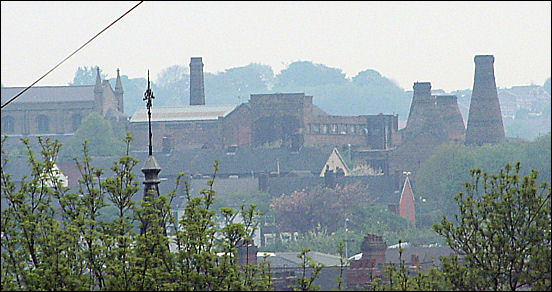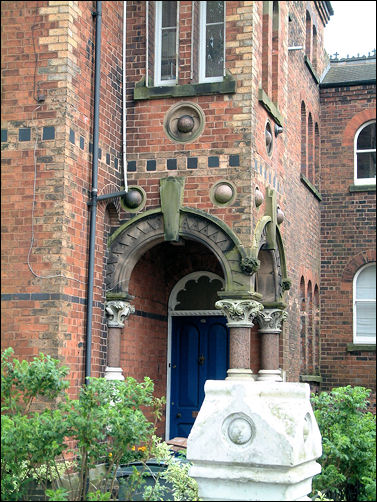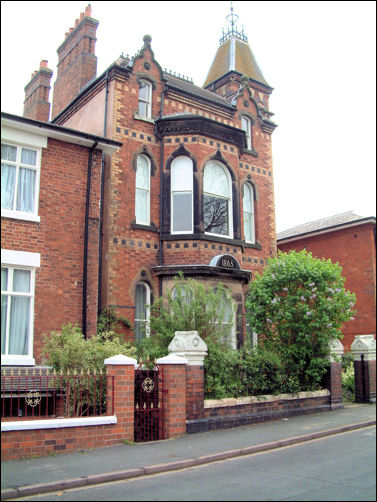|
Moneto House, Ricardo Street,
Dresden
  
click the
"contents" button to get back to the main index & map
previous: Bournes Bank, Burslem
next: the Bridle Path, Dresden
|
Historian Fred Hughes
writes....
There are some places that draw you back like a bee to a hive or a bird to
its nest; a honeymoon spot say, or a childhood holiday beach. For me such
a place is Dresden. Yes, I do mean Dresden Stoke on Trent, that sprawl of
streets and houses crammed between the A50 and Queen’s Park. But my, what
streets, what houses!
“I know where you’re coming from,” observes historian Steve Birks dryly.
“I too have always had a soft spot for Dresden. Historically it’s unlike
any other location in the Potteries because it grew from the district’s
first Freehold Land Society. It goes back to 1793 when George III
government encouraged increased private house-building.
Lending money for house-building introduced so-called Friendly Societies
whose members deposited money enabling them to borrow from a bigger
shared pot. They were commonly known as ‘self-building societies’. The
first was the Greenwich Building Society in 1809 who lent shared-money
tied to interest repayment. It’s from these beginnings our modern
mortgage banks take root.”
|
Collective land-buying to partition plots for individual sale was
right up the street, as it were, of local builders linked to burial
societies and provident clubs. In the absence of planning restrictions a
purchaser could build a house to any specification. And once all the
land was sold and the last repayment was made, the building society
simply disbanded. Those that remained became known as Permanent Building
Societies.
“The crucial electoral qualifications in the early 19th
century were based on ownership of a freehold with a minimum value of 40
shillings, and the occupation of a house with a rateable value of at
least £10 a year,” says Steve. “This is why many radical Liberals became
sponsors of the new ‘self-building societies’. They were simply
vote-catching.”

In mid-19th century Longton potbanks occupied the middle
of the town.
In mid-19th century Longton potbanks occupied the
middle of the town. Most of the surrounding land was owned by private
landowners the biggest of which was the Duke of Sutherland. But the
arrival of the Longton Freehold Land Society changed the landscape by
buying Spratslade Farm in 1854 for £5,000 and calling it Dresden.
“The Society’s membership was registered to 200,” says Steve. “Ten years
later 505 houses had been built on this freehold estate and you can see
the individuality of whim and passion in the variety of architecture.” |
Indeed if you walk along the streets the shock of architectural
diversity is immediate, particularly in Ricardo Street where there is no
single word other than WOW that fits the house at number 53 – Moneta
House, sometimes called Tower House. This astonishing pile of bricks and
stone was contrived in 1865 by a Nottingham architect named Sutton and is
outrageously at odds with the rest of the street having the Gothic
characteristics of Citizen Kane’s Xanadu. It is a creation in
red-and-yellow ornamented with carved stone lintels and preposterous
marble globes half-buried in its façade as though the walls had been laid
siege-to and pummelled with cannonballs. Its current owners are Keith and
Chris Duffy.

Gothic characteristics of Moneta House with marble globes half-buried in
its façade as though the walls had been laid siege-to and pummelled with
cannonballs.
“It’s not just a home to us,” says retired midwife Chris, “It’s a lifelong
project that we’ve inherited. And lifelong seems to be the best and
perhaps the only word to use. We bought the house six years ago and have
continued restoration work to bring it back the way it used to be, the way
the architect intended it. Luckily most of it is intact.”
Four storeys rise above the sandstone steps of an exposed basement, while
the tower rests upon arched marble columns with humorously unaligned
capitals supporting an open porch. It is gaunt, majestic and comical all
in one go. But it’s the interior quirky nick-knacks and hideaways that
impress most. Ceiling ventilators and decorative roses adorn spacious
rooms. Wrought-iron fretted banister supports lure the eye as the stairs
climb to the turreted simulated ramparts.

number 53 – Moneta House, sometimes called Tower House.
“There’s a small tower room on each floor,” says Chris detailing her
extensive inventory. “They are treasures just to peep into as you walk
by. That’s how wonderful the house is. It’s just a joy to wander in and
out the rooms simply looking and touching the pitch-pine woodwork and
gazing at the intricate depth of the cornice mouldings, marble
fireplaces, carved brass knobs and walk-through wide door arches.”
Up and up we climb following the winding staircase until we reach the
attic.
“Now look through the window,” commands Chris. And there unfolding before
me is the whole of Longton in one gorgeous panorama. “I think that’s one
of the finest views in Stoke on Trent,” she whispers almost inaudibly. I
just look in awe.
|
For all the love Chris and Keith have for the house its previous owner was
less in thrall to it. Moneta House was known to the artist June Burnett as
Tower House. It was her residence for 40 years.
“I can’t say it was my home,” reflects June. “It was my husband Philip’s
passion. He loved it because it was big enough for a library to house his
two-thousand books.”
June, whose work is currently being exhibited at Keele University, did
however use the house as a studio. She left some of her work behind
painted in a number of wall murals. It is work that Chris adores, refusing
to remove or paint over.
“Why did we buy the house?” muses June. “Well it had been multi-occupancy
accommodation for years and was being sold cheaply. Amazing when you think
that no-one wanted to buy possibly one of the most exciting houses in the
Potteries. But it was a wreck. Surprisingly though most of the entire
original features were intact.
Philip died a few years back. It was time for me to move on. It is lovely
but I don’t miss it.”
|
I came to Dresden to write about the old Bridle Path. But once again I
find myself fantastically sidetracked, so that story will have to wait
until next week.
 More on
Dresden and the
Freehold Land Society
More on
Dresden and the
Freehold Land Society |
![]()
![]()
![]()